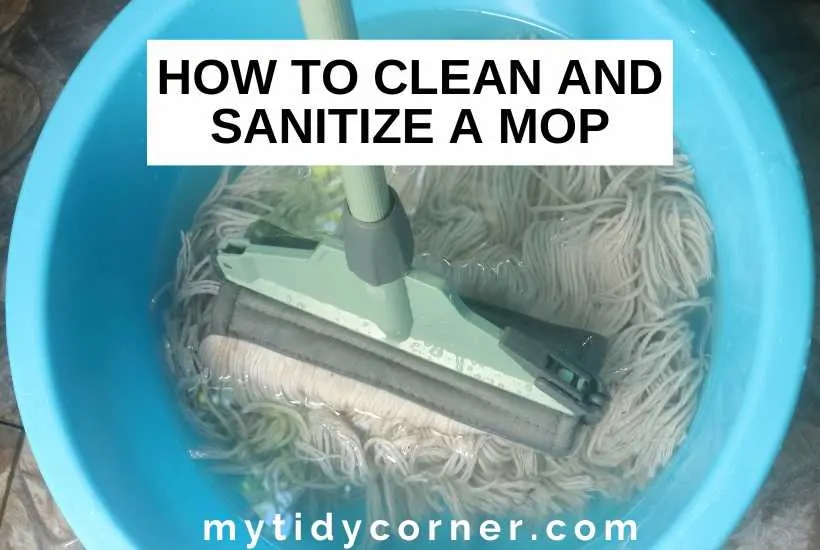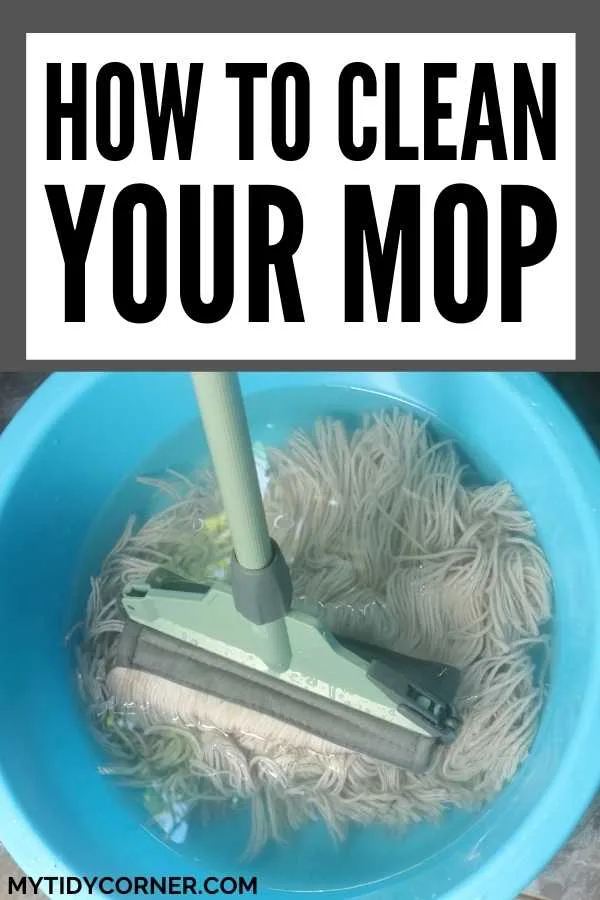How to Clean a Mop – Cleaning and Sanitizing Your Mop Head
Learn how to clean a mop the proper way. Cleaning and sanitizing your mop will help keep harmful bacteria and other germs from spreading on your floors.
How often do you mop your floors? Daily? Weekly? Less often? No matter how often your mop is used, it is a safe bet it gets pretty dirty.
Dropped food, mud, pet messes, and more can all add to the funk growing in your mophead.
Learning how to clean and sanitize your mop is the only surefire way to ensure you are not spreading what is on the mop back onto your floors.

Related Cleaning Articles:
- How to Clean and Disinfect Your Home after Sickness
- 26 Things You Should Definitely be Cleaning that May Not be too Obvious
Why You Should Clean Your Mop
The floors of your home are filled with bacteria such as Staphylococcus, Bacillus, Micrococcus, and Pseudomonas.
While these are not likely to make a healthy person sick, they are still not bacteria you want hanging around. Cleaning and disinfecting your mop with one of these simple methods can help to keep these bacteria at bay.
Cleaning a Wet Mop
Clean off Surface Dirt from Your Mop
To begin cleaning and disinfecting your wet mop, you will need to clean the surface dirt from it.
To do this, run clean hot water over it until it is thoroughly saturated while filling a bucket full of clean, hot, and soapy water as well.
Once the mop is dripping wet, use the bucket of water to churn the mophead 15-20 times. This should remove any surface dirt that may be clinging to the mop.
Soak Your Mop in Hot Water
The first method of sanitizing your mop is excellent for cotton mops or rag mops. It simply involves boiling a few gallons of water and saturating the mop in the water.
Once the mop is saturated, allow it to sit in the water until it cools.
After the mop is cool enough to touch, wring it out and let it fully dry. Most bacteria cannot withstand temperatures this hot for an extended time, and as such, allowing the mop to sit in the water will help kill them off.
If you would like to add cleaning to this step, add your favorite soap to the bucket. It should be said that while this will kill any bacteria that cannot tolerate high temperatures, it may not kill all bacteria that are on your mop.
Sanitize with Bleach or Lysol
Chlorine bleach has long been known to be a very effective sanitizer and can be used to sanitize your mop.
The process is very much like sanitizing your mop with boiling water, but you will have to use warm water in this case instead of hot water.
This is because adding chlorine bleach to hot water can create chlorine gas, which can be harmful when inhaled.
Clean the surface of your mop and fill a 5-gallon bucket with warm water.
Add bleach to the bucket, followed by the mop. Churn the mop several times to ensure the bleach water penetrates the core of the mop.
Allow it to sit for a while, then rinse thoroughly with cool water. Dry the mop and hang.
Different brands of bleach may not have the same strength as other brands. Because of this, use the guidelines on the side of the bottle for how much bleach you will need to add to achieve a sanitizing effect.
Aside from bleach, Lysol is the next best commercially available sanitizer. Lysol may reduce more types of bacteria because it is manufactured for the specific purpose of sanitizing. The method is the same as sanitizing with bleach.
Sanitize with White Vinegar and Essential Oils
For a more natural option, white vinegar and essential oils can be used to sanitize your mop. Studies have shown that white vinegar is nearly as effective at sanitizing as bleach. Certain essential oils have also been shown to be sanitizing as well.
To sanitize your mop naturally, add tepid water to a bucket. Since you are using essential oils, you do not want to use boiling water as excessive heat will destroy the sanitizing properties of the oils.
For each gallon of water you use, add 1 cup of white vinegar and 20 drops of your chosen essential oil.
You can use lemon, orange, or tea tree oil. Other oils that can sanitize are lavender, oregano, and eucalyptus oils.
Use a large spoon to combine the ingredients, then saturate your mop. Churn the mop several times to ensure the cleaning solution can penetrate to the center of the mop.
Allow your mop to sit 30-60 minutes to ensure the vinegar and essential oils have time to disinfect. After it has rested, rinse it thoroughly with clean water.
Washing Your Mop in a Washing Machine
You can also wash your mop head in a washing machine, but this is only applicable to detachable mop heads. Wash them together with other dirty rags and add a cup of bleach to disinfect. After washing, let the mop air dry.
Cleaning a Dust Mop
You should clean your dust mop after every 3-4 uses. To avoid the accumulation of dirt on your dust mop, shake off the dirt into your trash after every use.
Vacuum with the Tube Attachment
One of the easiest ways to clean a dust mop is to use the tube attachment of your vacuum to suck out the dirt and debris. Run the tube attachment over the mop head several times until it’s clean and dust free.
Hand Washing
Soak the mop head in lukewarm soapy water for 10-15 minutes, wash by hand to remove the dirt, rinse with clean water and let it air dry.
Washing a Dust Mop in a Washing Machine
Like the wet mop, you can also wash a dust mop in a washing machine. However, for microfiber dust mops, wash on low heat and after washing, hang to air dry. You should also avoid using bleach and fabric softer when washing a microfiber mop in a washing machine.
Final Thoughts on How to Clean a Mop
Cleaning and sanitizing your mop may not be something most people think about doing. However, to help keep your family healthy and your home as bacteria-free as possible, it should be done after each use.
For spot mops such as reusable microfiber mops, once a week is often enough to sanitize the mopping pads.
No matter which option you choose, be sure to wring as much excess water from it after you rinse it, let it air dry and put it back in your cleaning closet. Allowing excess water to stay in the mop while it dries can act as a breeding ground for molds and mildews.
Did you find the tips on how to clean a mop helpful? Leave your comment below.

